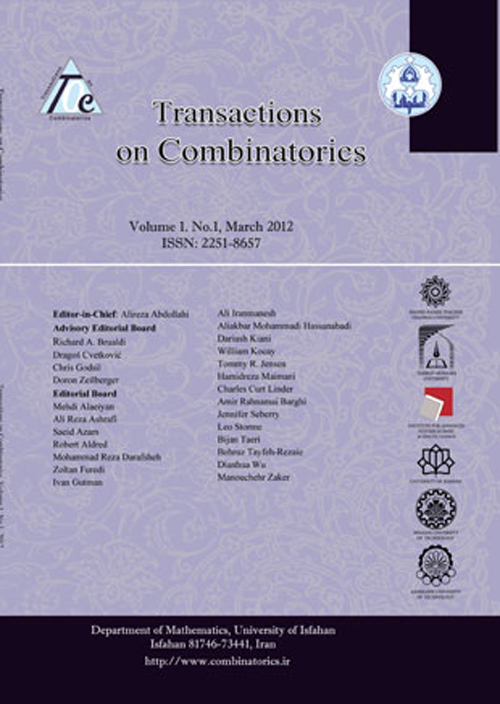فهرست مطالب

Transactions on Combinatorics
Volume:10 Issue: 1, Mar 2021
- تاریخ انتشار: 1399/12/13
- تعداد عناوین: 5
-
-
Pages 1-8
Let $G$ be an $n-$vertex graph with $m$ vertices. The degree deviation measure of $G$ is defined as $s(G)$ $=$ $sum_{vin V(G)}|deg_G(v)- frac{2m}{n}|,$ where $n$ and $m$ are the number of vertices and edges of $G$, respectively. The aim of this paper is to prove the Conjecture 4.2 of [J. A. de Oliveira, C. S. Oliveira, C. Justel and N. M. Maia de Abreu, Measures of irregularity of graphs, Pesq. Oper., 33 (2013) 383--398]. The degree deviation measure of chemical graphs under some conditions on the cyclomatic number is also computed.
Keywords: irregularity, degree deviation measure, chemical graph -
Pages 9-29Given a simple graph $G$, the distance signlesss Laplacian $D^{Q}(G)=Tr(G)+D(G)$ is the sum of vertex transmissions matrix $Tr(G)$ and distance matrix $D(G)$. In this paper, thanks to the symmetry of $D^{Q}(G)$, we obtain novel sharp bounds on the distance signless Laplacian eigenvalues of $G$, and in particular the distance signless Laplacian spectral radius. The bounds are expressed through graph diameter, vertex covering number, edge covering number, clique number, independence number, domination number as well as extremal transmission degrees. The graphs achieving the corresponding bounds are delineated. In addition, we investigate the distance signless Laplacian spectrum induced by Indu-Bala product, Cartesian product as well as extended double cover graph.Keywords: Distance signless Laplacian matrix, Eigenvalue, transmission regular graph, spectral radius, graph operation
-
Pages 31-42We study two foremost Mahonian statistics, the major index and the inversion number for a class of binary words called restricted Fibonacci words. The language of restricted Fibonacci words satisfies recurrences which allow for the calculation of the generating functions in two different ways. These yield identities involving the $q$-binomial coefficients and provide non-standard $q$-analogues of the Fibonacci numbers. The major index generating function for restricted Fibonacci words turns out to be a $q$-power multiple of the inversion generating function.Keywords: Major index, inversion, Fibonacci
-
Pages 43-61Let $G = PSL_{2}(q)$, where $q$ is a power of an odd prime. Let $M$ be a maximal subgroup of $G$. Define $leftlbrace frac{|M|}{|M cap M^g|}: g in G rightrbrace$ to be the set of orbit lengths of the primitive action of $G$ on the conjugates of a maximal subgroup $M$ of $G.$ By using a method described by Key and Moori in the literature, we construct all primitive symmetric $1$-designs that admit $G$ as a permutation group of automorphisms.Keywords: 1-design, symmetric designs, primitive design, projective special linear group
-
Pages 63-71Let $G=(V,E)$ be a simple graph with $nge 3$ vertices, $m$ edges and vertex degree sequence $Delta=d_1 ge d_2 ge cdots ge d_n=delta>0$. Denote by $S={1, 2,ldots,n}$ an index set and by $J={I=(r_1, r_2,ldots,r_k) , | , 1le r_1<r_2<cdots<r_kle n}$ a set of all subsets of $S$ of cardinality $k$, $1le kle n-1$. In addition, denote by $d_{I}=d_{r_1}+d_{r_2}+cdots+d_{r_k}$, $1le kle n-1$, $1le r_1<r_2<cdots<r_kle n-1$, the sum of $k$ arbitrary vertex degrees, where $Delta_{I}=d_{1}+d_{2}+cdots+d_{k}$ and $delta_{I}=d_{n-k+1}+d_{n-k+2}+cdots+d_{n}$. We consider the following graph invariant $S_{alpha,k}(G)=sum_{Iin J}d_I^{alpha}$, where $alpha$ is an arbitrary real number, and establish its bounds. A number of known bounds for various topological indices are obtained as special cases.Keywords: graphs, vertex degrees, graph invariants

